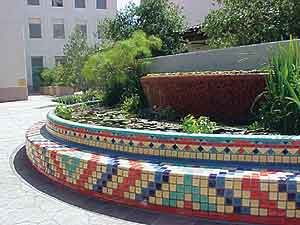|
|
Many of today's gardeners are under the erroneous assumption that water gardens are a contradiction to water conscious gardening. With various areas of the nation facing drought conditions from time to time, this assumption needs correction. Not only do water-filled gardens use very little water, but they also provide psychological benefits in an otherwise arid environment.
Department of Water Resources statistics indicate that 1,000 square feet of grass consumes approximately 27,000 gallons of water annually, while a 15' x 30' foot pool surrounded by decking requires only 17,000 gallons per year. Additionally, an evaporation study by the U.S. Conservation Lab in Phoenix, Arizona, discovered that water lilies and other aquatic plants reduce evaporation by 10 percent.
While it's true that large, cascading waterfalls and far-spraying fountains are not particularly water efficient, the carefully planned pond can be a water saver in all types of landscaping plans. Here are several suggestions for making your pond water efficient:
CONSTRUCTION - Pond leakage can be one area of water loss. However, with today's new pond construction materials and building techniques, water leakage problems have been virtually eliminated. In contrast to the typical garden where most of the water percolates through the ground, pond water does not seep away. Ponds constructed with depths of 18" - 24" and sides straight; up and down, rather than sloping, have less water loss by evaporation.
AQUATIC PLANTS - All plants give off moisture, some more than others. Tall plants with more leaves transpire more moisture than low growing plants under 12" in height. Some water saving aquatic plants include Water Lilies, Water Hawthorne, Pennywort, Water Cress, Primrose Creeper, and Duckweed.
TIMERS - For maximum conservation of both water and electricity, put a timer on your water features - waterfalls and fountains - so they're off during the day when no one is home. Without a timer, turn the features on only when you're outside to enjoy them.
WIND BLOCKS - If you live in a windy location, you can reduce pond evaporation by building a wind block. Be careful when selecting bushes and trees that they are non-toxic.
TUB GARDENS - You don't need a large body of water to enjoy water gardening. Small tub gardens, strategically placed, can do much to brighten and sparkle corners of your yard, balcony or patio. One of the nicest, not-to-be-overlooked benefits of water gardening is purely psychological. Just when everything else seems dried-out and arid, your water garden can be a quiet haven of relaxation, your own backyard oasis.


